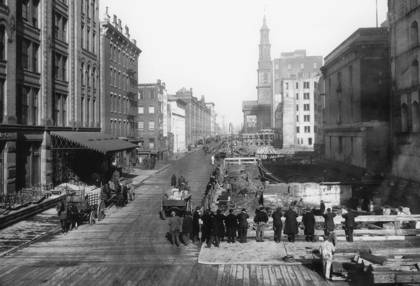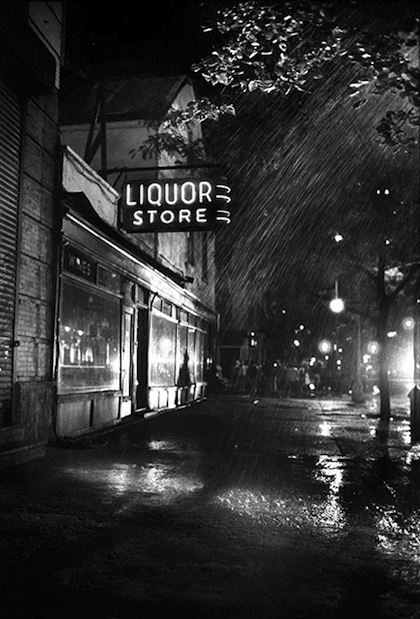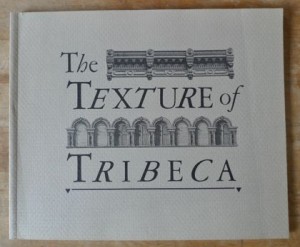Nosy Neighbor: Can You Recommend Any Tribeca Picture Books?
 I was wondering if you had any recommendations for picture books on Tribeca. I’m looking for a coffee table style book for a gift for a former local. —M.
I was wondering if you had any recommendations for picture books on Tribeca. I’m looking for a coffee table style book for a gift for a former local. —M.
The best historical option is Oliver E. Allen’s Tribeca: A Pictorial History ($50),which is sold at Working Class Emporium on Duane. The image at top is from the book; it’s of the construction of the subway line up Varick, between Franklin and N. Moore. As you may know, Allen is the history columnist at the Tribeca Trib. His previous Tribeca book, Tales of Old Tribeca, is also good (used copies run $38–$190 on Amazon).
 For something contemporary, there’s photographer Donna Ferrato’s sumptuous Ten Years in Tribeca, which includes the Liquor Store image at left (one of my very favorites). The book includes photos taken around the neighborhood in the decade after 9/11, but they’re not really about the dreadful event so much as Tribeca itself. You can buy it for $75 here.
For something contemporary, there’s photographer Donna Ferrato’s sumptuous Ten Years in Tribeca, which includes the Liquor Store image at left (one of my very favorites). The book includes photos taken around the neighborhood in the decade after 9/11, but they’re not really about the dreadful event so much as Tribeca itself. You can buy it for $75 here.
I also like The Texture of Tribeca, a paperback book published in 1989 by the Committee for the Washington Market Historic District with text by Andrew Scott Dolkart and historical photos. Used copies are $60–$145 on Amazon.
 If anyone has other recommendations, please pass them along!
If anyone has other recommendations, please pass them along!
Got a question? Email it to tribecacitizen@gmail.com.
Previous “Nosy Neighbor” posts:
• Why are those shuttles on Greenwich?
• What’s coming to 15 Canal Street?
• Who enforces sidewalk-café regulations?
• What’s going on at 27 Desbrosses?
• What happened to the Lilac?
• When will those trailers on West Street go away?
• Do you know anything about 20-24 Varick?
• What’s happening to my parking lot?
• Is Pier 26 being worked on again?
• What’s up with Jin Market?
• What are those black pellets on Pier 25?
• What do the characters on 47 Vestry mean?
• When is T.J. Maxx opening?
• Where is the Special Forces monument going?
• Who’s moving into 151 Hudson?
• What’s going on at 172 Duane?
• Where is Compose’s pastry chef cooking now?
• What’s up with those Verizon carts?
• Where was the original Blues Bar?
• Who are the guys in the geeky pants?
• Why are the windows above Ponte’s boarded up?
• Can we walk on the West Street medians?
• What’s going on in 157 Hudson?
• What’s the new painting at 153 Hudson?
• What’s up with 55 Warren/55 Murray?
• What is this P.C. Richard & Son Theater I keep hearing about?
• What’s the story behind the lights at 289 Church?
• What’s the Dream House at 275 Church?
• How come every every film and TV shoot seems to have a trailer with doors marked “Lucy” and “Desi”?













More an interesting curiosity than a photo book, TRIBECA GUIDE 2000 was published by the local BID the Tribeca Partnership. Don’t know where you could find a copy.
By the way, a wonderful history of Tribeca can be found on the nyc.gov web site under the North Historic District. And of course, there are wonderful photos all over the web. Check out the Washington Market which is the real name of Tribeca.
Nice question, and very good answer. Because Tribeca and the Financial District are the original Colonial New York, any book about New York’s early colonial history also has many images and narratives about the area. I write about Tribeca’s and Wall Street’s history, then and now, for NearSay.com. I focus on the waterfront. In the past year, I’ve written more than a hundred articles, focusing on this unique history. http://newyork.nearsay.com/blog/pearlduncan
The New York Public Library’s Digital Photo Collection has some unique images, from early colonial days to the present. http://digitalgallery.nypl.org/nypldigital/index.cfm S
Search by the street names, and all the photos appear for the past centuries and today.
The area and characters are so fascinating, I wrote a book about the 18th-century merchant cargo ship discovered in the foundations of the World Trade Center, which my agent has. He has the manuscript, so the book will be available in a year or so. Only a few photos, but fascinating description of the larger than life folks who built the neighborhood and transformed New York and its harbor into a world-class place. Even in the 18th-century, New York Harbor was where the action was.
Your friend may also enjoy the new novel set in Tribeca — “Triburbia” by Karl Taro Greenfield.
@Pearl: Thanks for the suggestions. FYI I plan to cover “Triburbia”—which will definitely be of interest—closer to when it’s published, which won’t be till July or August.
Hi Erik, I look forward to you review of “Triburbia,” and to reading the novel. The neighborhood is so unique historically and in it’s evolution. I’m sure there will be more creative works in many genres featuring Tribeca. I included a scene is one of my short stories in “Water Dancing,” (1990s) of a sculptor sculpting a massive work on the street by the river on a Sunday morning. So many artists worked outside on the sidewalks, on loft buildings’ loading docks, on the piers — when Tribeca was an artists’ neighborhood. Now that it’s evolved into a high-end condo surburbia, the stories have changed, and the area inspires all kinds of creative narratives, from the colonial eras to the present. So we’ll see. Let’s enjoy them all.